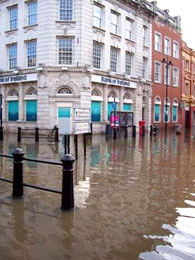The Importance of Emergency Planning (4 of 4)

What happens if plans are incomplete?
This local studies library was flooded during 2009. Initially, only a small amount of objects (a couple of crates) were affected and required freeze-drying. In the Emergency Plan, the library had details of the contract in place with a disaster recovery firm - who quoted approximately £150 for this work to be carried out.
Unfortunately, the plan contained no details of who would provide authorisation for this spend, and it eventually took 5 days to get the payment authorised. By this time, all the objects had turned mouldy, and they required considerably more expensive treatment.
It is worth noting that, in some cases, even the best laid plans are not sufficient. It is important to consider every eventuality, and to plan appropriately. In the Carlisle floods of January 2005, several museums were affected, and required help to stop the influx of water. The plans stated that the local council could provide sandbags, and that the fire brigade would pump out any standing water. Unfortunately, both the fire brigade and the local council were flooded themselves, and in no position to help others - or certainly not immediately!!!
